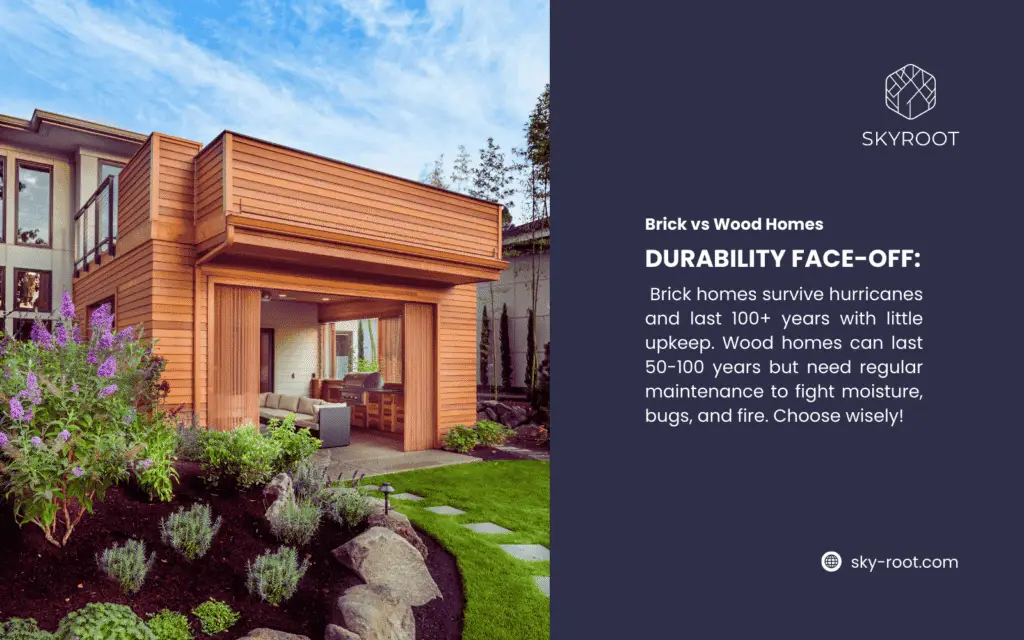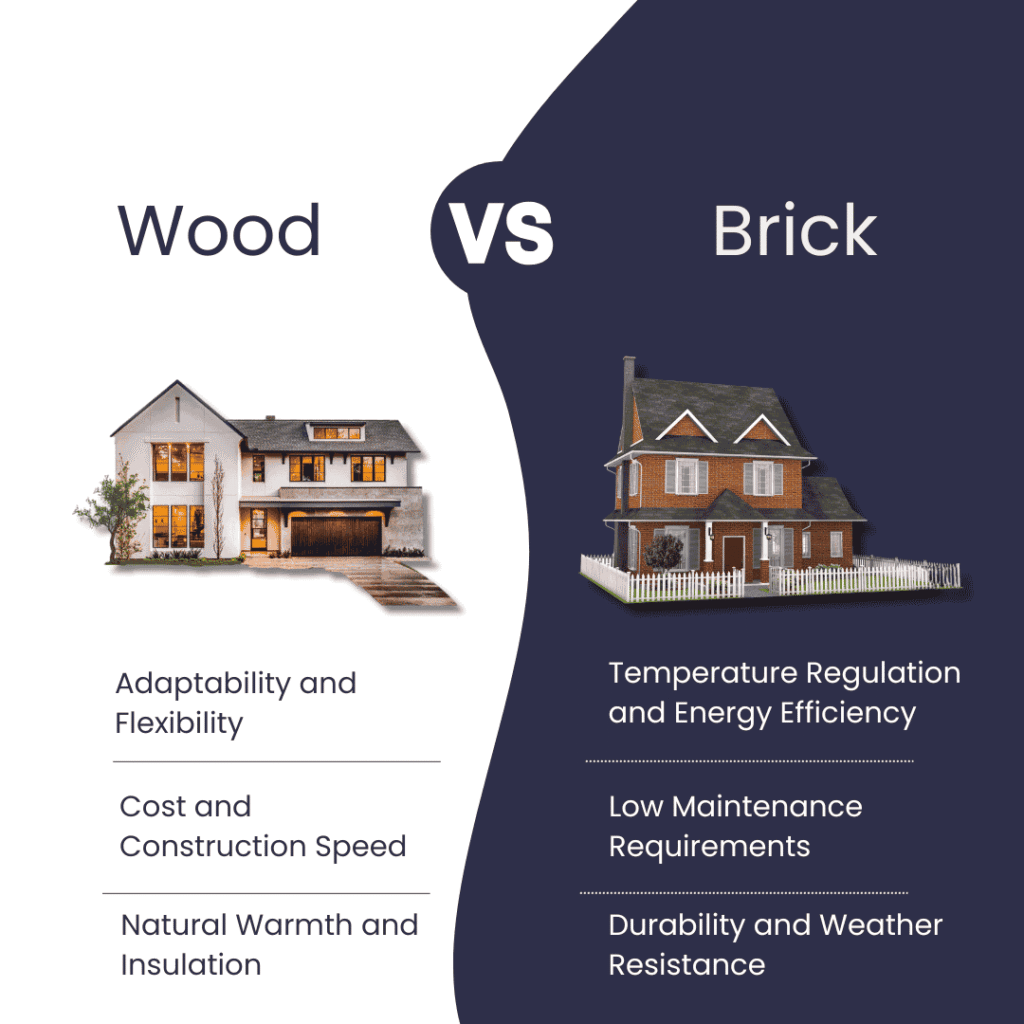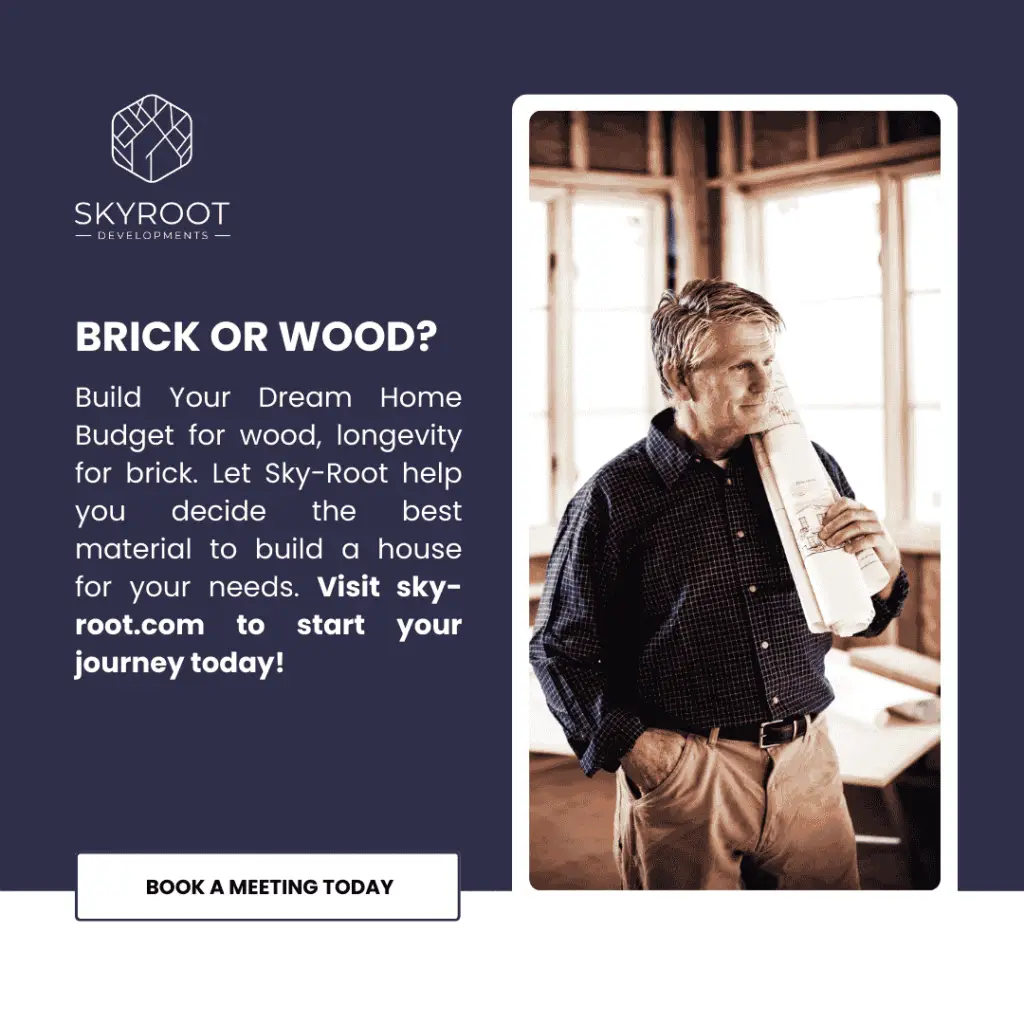When building a house, you probably do your research on these things. Will we have a brick or a wood house? Or concrete?
After a long research process, you will realise that choosing between a brick vs wood house isn’t just about aesthetics.
Your perfect choice depends on whether you live in hurricane alley or snow country, whether you’re planning to pass this home down to your grandkids or flip it in five years, and yes – whether you’re the type who enjoys home maintenance projects or would rather never climb a ladder again.

Over the next few minutes, I’m going to walk you through what I wish someone had explained to me – the pros and cons of both brick and wood homes from someone who’s been through the entire messy, wonderful process.
Brick vs Wood House: A Look at the Previous Experiences
To have a better look at these houses, we need to have a look at how they stood up to the time. Did they collapse at the sight of a tornado or a flood? How do they perform from a temperature view and so much more.
A Look at Brick Homes
Last summer, I took my kids to visit Philadelphia’s historic district. While they were more interested in finding the nearest ice cream shop, I couldn’t stop staring at the brick rowhouses that have been standing since the 1700s. These homes have weathered nearly 300 years of harsh winters, sweltering summers, and everything in between.
People have been firing clay bricks since 5000 BCE, and the Romans loved the material so much they spread brick-making techniques throughout their empire.
So, when someone says, “brick homes last forever,” they’re really telling the truth. The proof is standing all around us.
What About Wood Homes?
Roughly 90% of new American homes are built with wood framing. We’ve been a nation of wood-lovers since the first settlers arrived and found themselves surrounded by seemingly endless forests.
The game-changer came in the 1830s with something called “balloon framing” – a technique that made wood homes quicker and cheaper to build. This innovation was so significant that it literally helped America expand westward, as families could build homes rapidly without needing a village of skilled masons.
What’s fascinating is how we’ve continued to refine wood construction. The treated lumber in today’s market bears little resemblance to what our grandparents built with, making modern wood homes far more resilient than their predecessors.
The Comparison of Brick vs Wood Houses
Let’s cut to the chase and get into what you’re really here for – the practical differences that will affect your life if you choose brick or wood. I’ve broken this down into the categories that cause the most heated debates.
But Will It Last?
When Hurricane Matthew tore through a neighborhood in 2016, many gained a new appreciation for brick. While several wood-sided homes needed significant repairs, most brick homes stood virtually untouched.
Brick doesn’t rot, termites turn their noses up at it, and it can take a serious beating from Mother Nature. A well-built brick home can easily last 100+ years with minimal intervention from you.
But modern treated lumber and advanced construction techniques mean a well-built wood home can still give you 50-100 solid years. Yes, wood is more vulnerable to moisture, bugs, and fire, but these risks can be managed with proper maintenance. If you’re willing to stay on top of inspections and upkeep, a wood home can serve multiple generations beautifully.
How Much Is This Going to Cost Me?
Brick is going to cost you more upfront – typically 15-25% more than wood frame construction.
Full brick homes (where brick is used structurally, not just as veneer) push that price tag even higher. But it’s safe to say what you pay upfront, you’ll likely save in the long run.
If you’re building on a tight budget, wood is going to be a better choice. Not only are the materials less expensive, but the construction moves faster (meaning lower labor costs) and doesn’t require as many specialized skills.

How Much Weekend Work Am I Signing Up For?
The beauty of brick is what it doesn’t need: no painting, no staining, no replacing rotted sections. Just occasional cleaning if you’re feeling ambitious.
Wood homes are like classic cars – beautiful, but they’ll ask more of your time. Depending on your climate and exterior finish, you’re looking at repainting or restaining every 5-10 years. In harsh environments, some siding might need replacement after a couple of decades.
A friend of mine who has a wood-sided home in coastal Carolina requires almost religious maintenance to combat salt air and humidity. Meanwhile, his neighbor with a brick house hasn’t done a thing in 15 years. These ongoing costs can easily erase the initial savings if you’re not careful – or if you’re the type to procrastinate on maintenance.
But What About My Energy Bills?
The brick home stays noticeably cooler throughout the day, warming up much more slowly than the wood home. This is because of brick’s high thermal mass – it absorbs and releases heat gradually, helping to moderate indoor temperatures.
The flip side? Brick alone is a lousy insulator. Modern brick homes compensate with additional insulation layers, but older brick homes can be energy hogs without proper updates.
Wood-frame construction creates perfect wall cavities for stuffing with insulation, which can make for an energy-efficient home when done right. The wood itself adds some insulating properties, though not enough to matter without proper additional insulation.
Am I Being Eco-Friendly?
Making bricks isn’t exactly a green process. The manufacturing requires serious energy and produces significant carbon emissions. However, bricks are made from abundant natural materials (clay and shale), and their incredible longevity means you won’t be replacing them in your lifetime.
Many brick manufacturers have been cleaning up their act with more sustainable practices, but if environmental impact is your primary concern, you’ll need to research specific manufacturers carefully.
Wood can be one of the most environmentally friendly building materials around – when sourced responsibly. It’s renewable, requires less energy to produce than brick, and actually stores carbon throughout its lifetime.
The catch is thought that irresponsible lumber harvesting contributes to deforestation and habitat destruction. If you’re building with wood, look for lumber certified by the Forest Stewardship Council (FSC) or similar organizations that verify sustainable practices.
Where You Live Matters
After consulting with builder friends across the country, I’ve come to realize that the best material to build a house often comes down to one simple question: “Where are you building?” Here’s what I’ve gathered from real conversations with homeowners:
| Region | What Mother Nature Throws at You | What Locals Typically Choose & Why |
| Hot, Humid Southeast | Hurricanes, termites, mold, and humidity that feels like breathing through a wet towel | Brick dominates for good reason – it stands up to hurricane-force winds and says “no thanks” to termites and mold |
| Cold Northeast | Freezing temperatures that would make a polar bear shiver, heavy snow loads | Either material works well with proper insulation, though many prefer wood’s natural insulating properties |
| Midwest | Tornadoes that can turn a pickup truck into a missile, temperature swings from -20°F to 105°F | Brick gets the edge for standing up to debris in tornado-prone areas, but well-built wood homes with reinforcement can perform admirably |
| Earthquake-Prone West | Ground that occasionally decides to dance the cha-cha | Wood wins hands-down for flexibility – brick can crack and crumble during seismic activity while wood frame homes flex and survive |
| Wildfire Zones | Fire. Lots of fire. | Brick or other non-combustible materials are often mandatory in these areas, and for good reason |
| Coastal Areas | Salt air that corrodes metal faster than teenagers empty a refrigerator | Either material needs special treatment – brick needs proper sealing against salt infiltration, wood needs marine-grade treatments and finishes |
Can’t Decide? You Don’t Have To
Many modern homes use a practical hybrid approach – wood framing on the inside (where it’s protected from the elements) with a brick veneer exterior (where you get the aesthetic and weather-resistant benefits). This clever compromise gives you:
- The cost savings and structural advantages of wood framing where it matters
- The curb appeal and weather resistance of brick where it faces the elements
- Better insulation options than full brick construction
- Significantly better resistance to nature’s fury than pure wood construction

What Really Matters to YOU
After hundreds of conversations with homeowners, I’ve noticed that the brick vs wood house decision ultimately comes down to four personal factors:
The Money Question
Be brutally honest with yourself here. Are you working with a tight upfront budget but can handle ongoing maintenance costs? Wood might be your answer. Can you invest more now to save later? Brick could be worth the splurge.
My brother-in-law, a notorious penny-pincher, chose wood construction to save money upfront. Five years later, he admits he hadn’t factored in the cost of painting and repairs, which have already eaten up most of his initial savings.
The Look and Feel
This is where you need to trust your gut:
When you picture coming home every day, do you see the timeless solidity of brick with its natural texture and earthy tones? Or does your heart lean toward the natural warmth of wood, with its endless possibilities for colors and finishes?
Drive through neighborhoods that speak to you and notice which homes make you slow down and stare. That visceral reaction matters more than you might think.
Your Future Plans
Be realistic about your timeline.
Are you building your “until-they-carry-me-out” forever home? Brick’s durability and low maintenance might be worth every extra penny.
Planning to move in 5-7 years as your family grows or career changes? The lower initial investment of wood might make more financial sense.
The Neighborhood Norm
There’s wisdom in looking at what your neighbors have done:
In a neighborhood in Virginia, brick is so dominant that wood-sided homes stick out like sore thumbs and typically sell for less. Meanwhile, in parts of New England, a brick home might look oddly out of place among the classic wood-sided colonials.
Build Your Dream Home With Experienced Craftsmen Who Understand Both Worlds
Still feeling overwhelmed about choosing between brick vs wood construction? Let the experts at Sky-Root help you through this decision.
What makes Sky-Root different is their personalized approach. Rather than pushing one solution for every client, they take the time to understand your specific needs, regional considerations, and long-term goals before recommending the best material to build a house that’s perfect for YOU.
Schedule a consultation with Greg and Toni, and take the first step toward building a home that perfectly balances your aesthetic preferences, practical needs, and budget considerations.
